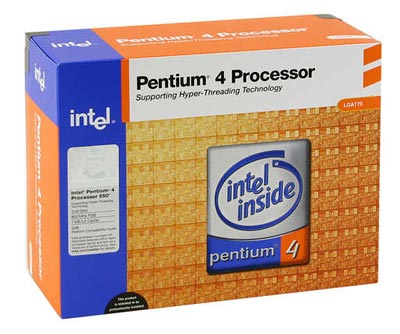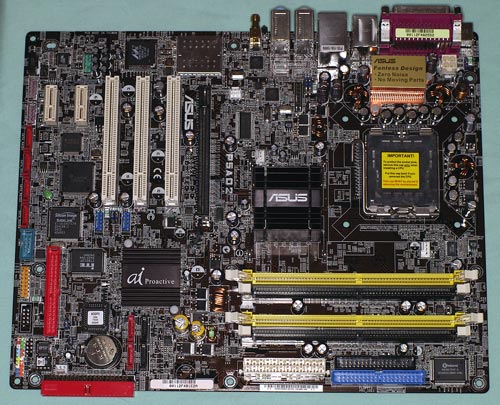High End Buyer's Guide - September 2004
by Wesley Fink on August 30, 2004 12:22 AM EST- Posted in
- Guides
CPU and Motherboard Alternatives
CPU: Intel Pentium 4 560 (3.6Ghz)Motherboard: Asus P5AD2 Premium (Intel 925X)
Price: CPU - $505 shipped (Retail with HSF). Motherboard - $264 shipped
It was difficult to decide between the Single-Channel Socket 754 Athlon 64 and the new Intel Socket 775 for the High-End alternative. Despite the massive increase in memory bandwidth that comes with the Dual-Channel 939, the fact remains that the Athlon 64 is not particularly bandwidth-starved compared to recent deep-pipe Intel designs. As you can see in the launch article on Socket 939, this translates into performance of the single-channel 754 Athlon 64 that is only 2% to 9% slower than the new 939 at the same speed. In real terms, this means that a Socket 754 combined with a second-generation Socket 754 motherboard with AGP/PCI locks is still slightly outperforming Intel's latest and greatest Pentium 4 560 (3.6GHz). The new pricing of the 2.4GHz 3700+ at about $525 also makes this tempting for the High-End Value shopper. The 754 is still a very good alternative, but in the end, the new Socket 775 on one of the motherboards that solves the Intel OC lock riddle won out as the High-End alternative due to the combination of features and future.

Intel produces processors with locked multipliers, so for raw performance, we chose the highest Intel stock speed. The Intel 560, running at 3.6GHz and based on the 90nm Prescott core, is the fastest Intel CPU you can buy today. As Anand found in the Socket 775 launch review CPU benchmarks, the 560 is generally faster than the more expensive 3.4EE, which has double the cache, but is based on the 130nm Northwood core. Most Socket 775 processors that we have tested tend to top out in the 3.8GHz to 4.0GHz range with modest voltage increases, so overclockers choosing a 775 CPU may want to choose a slower 775, like the 3.2GHz to balance ultimate overclock with board Clock frequency capabilities.
In this case, the Asus P5AD2 tops out at 278 with ATI PCIe video or about 260 with nVidia PCIe. We also showed, in our DDR2 memory roundup, that all current DDR2 memory could run at DDR2 667, which is achieved at a Clock frequency of 250. This means that if you are an experienced overclocker, you can achieve the same or higher performance with a 3.2E Socket 775 matched to the Asus P5AD2.
However, this is the High-End Buyer's Guide and there is no doubt that overall, the 560 is the fastest stock Intel Socket T processor that you can buy. This makes the 560 the ideal choice for a Socket T, PCI Express, DDR2 High-End system.

The Intel 925X chipset is Intel's Enthusiast chipset, and we recently compared 925X motherboards in our 925X Roundup. The Gold Editor's Choice in that roundup was the Asus P5AD2, which makes the Asus the logical choice for our High-End Intel system.
The P5AD2 Premium is clearly top-of-the-line in every way. All of the Asus Proactive AI (Artificial Intelligence) features are included, and Asus proudly advertises the overclocking features of the P5AD2 Premium. This includes a special cooling plate on the bottom of the board in the CPU area that Asus calls Stack Cool.
Asus includes Dual Gigabit PCI Express LAN on the P5AD2, with both LAN ports powered by the new Marvel 88E8053 Ethernet controllers. You will also find a complete WiFi set-up with an 802.11g card and antenna included for the WiFi slot. Asus uses the premium C-Media CMI9880 codec supporting the Intel High-Definition audio, with 8 channels and Dolby Digital Live technology support. The P5AD2 also adds the DDR2 memory option of 600MHz at stock speed in addition to the common 533 and 400 options.
The storage area is one area where the Asus stands out compared to other 925X boards. All 925X support the ICH6R standard 4 SATA/1 IDE (2drives) configuration. The Asus adds 4 more SATA ports for a total of 8 SATA ports, and also adds an ITE controller for 2 more IDE devices for a total of 4.
When Socket 775 was launched, it did not appear that any of the new 925X/915 motherboards would ever become a recommended performance motherboard. Performance was fine if you looked only at stock speeds, but the 925x/915 boards appeared limited to about a 10% overclock by design. This severely limited performance at the very top compared to Intel 875/865 chipset boards. However, the P5AD2 has turned out to be the best overclocker that we have seen so far among the 925X motherboards. In our tests, the Asus reached 278 FSB with the difficult combination of a top-end ATI X800 XT PCIe video card and a SATA hard drive. This puts the P5AD2 in the same performance ballpark as the best 875 boards, making it easier to choose a 925X system as the high end alternative system.
The P5AD2 is an expensive motherboard, but it will take 775 performance to places that are difficult to reach with other 925X motherboards. It was designed from the start to be a dream board for Performance computing, and Asus even provides a full range of AI overclock options for the more timid, with auto presets from 5% to 30% overclock, which represent a range of auto overclocks to FSB1066/DDR2-710.
There is also a full range of both familiar and new manual settings for overclockers who like to dial their own.
Listed below is part of our RealTime pricing engine, which lists the lowest prices available on the Intel CPUs and motherboards from many different reputable vendors:
If you cannot find the lowest prices on the products that we've recommended on this page, it's because we don't list some of them in our RealTime pricing engine. Until we do, we suggest that you do an independent search online at the various vendors' web sites. Just pick and choose where you want to buy your products by looking for a vendor located under the "Vendor" heading.










53 Comments
View All Comments
Avalon - Tuesday, August 31, 2004 - link
#30, the AMD system should be somewhat faster in gaming for you. As for 3D studio max, I'm not sure which.stevennoland - Monday, August 30, 2004 - link
The vid card price list does not include the X800 XT! What gives? I've tried to find them, but I'm really beginning to belive they don't exist.stevennoland - Monday, August 30, 2004 - link
jjkusaf - Monday, August 30, 2004 - link
oh...and would an Intel system be better for gaming and 3D Studio Max?jjkusaf - Monday, August 30, 2004 - link
OK...first of all thanks for taking your time in writing this guide.I am in the market of building a new computer and will pretty much use this guide to help make my decisions. My computer will primarily be used for gaming (Doom3, N2003, etc) and 3D Studio Max.
My first question is about the CPU cooler. I take it that the stock cooler was used (I do not intend on overclocking)? I do not intend on buying the FX...but just the plain ol' AMD 64 3800. If the stock cooler is not recommended...then what cooler is?
Also...any advantages of the N-Force3 over the Via chipset...and vice versa.
Thanks for the write up!
Wesley Fink - Monday, August 30, 2004 - link
#25 - As was stated on the last page (Final Words) of the Geil Ultra X 3200 review, the Geil tops out around 466 on AMD Athlon 64. That is why we selected a Micron chip memory for the A64 in the Guide.#26 - typo fixed.
gherald - Monday, August 30, 2004 - link
The mid-range system from last month came to just over $1000. Now you are recommending a $3600 system as "high-end"C'mon Anand, that's too big of a price step. Three and a half "mid-range" systems for the price of one "high-end" ?!?
There should be a guide at around the $2000-2300 mark for this to be balanced.
danidentity - Monday, August 30, 2004 - link
Another small typo,Page 6, Storage:
"Anand has shown that there is little performance advantage to SATA 1, but striping is still useful for improving boot times."
I believe that is supposed to say "little performance advantage to RAID 0", as the link points to a RAID 0 article.
Andrevas - Monday, August 30, 2004 - link
I'm surprised the OCZ Powerstream 520W wasn't chosen for both systems, IMO it is the best power supply, period.And I'd like to know how well the new Geil Ultra X DDR400 sticks fair with the AMD 64 platforms in OCing since they were able to hit DDR561 in your review on an Intel platform.
Plus no mentioning of the Logitech Z680s?
Other then those issues, I think the components chosen were great except for the case, but that's more of a matter of personal interest.
Wesley Fink - Monday, August 30, 2004 - link
#14 and #21 - That sentence was a cut and paste error and has been corrected on the AGP video page. The timeline for 925X/775 has also been updated by removing the time reference.